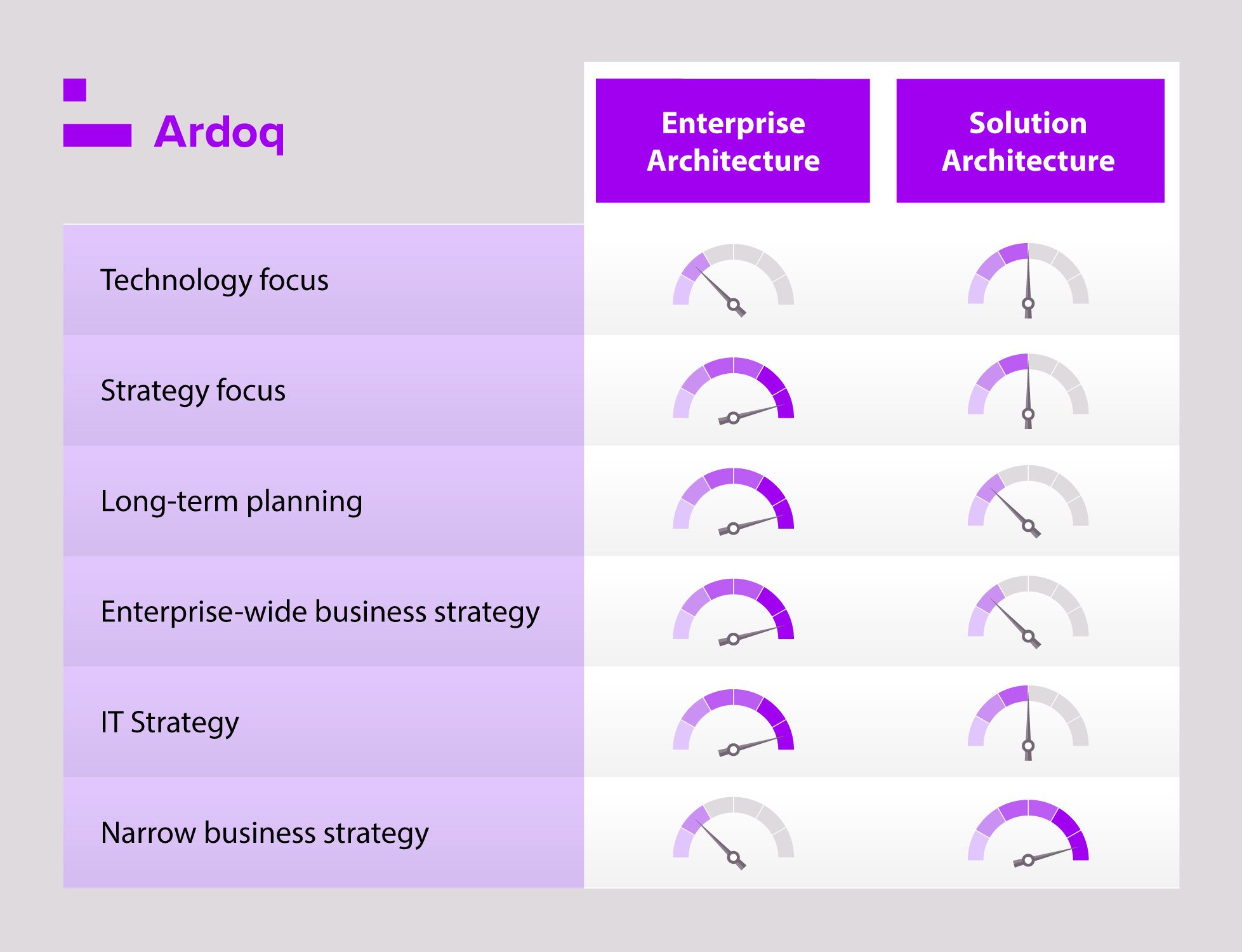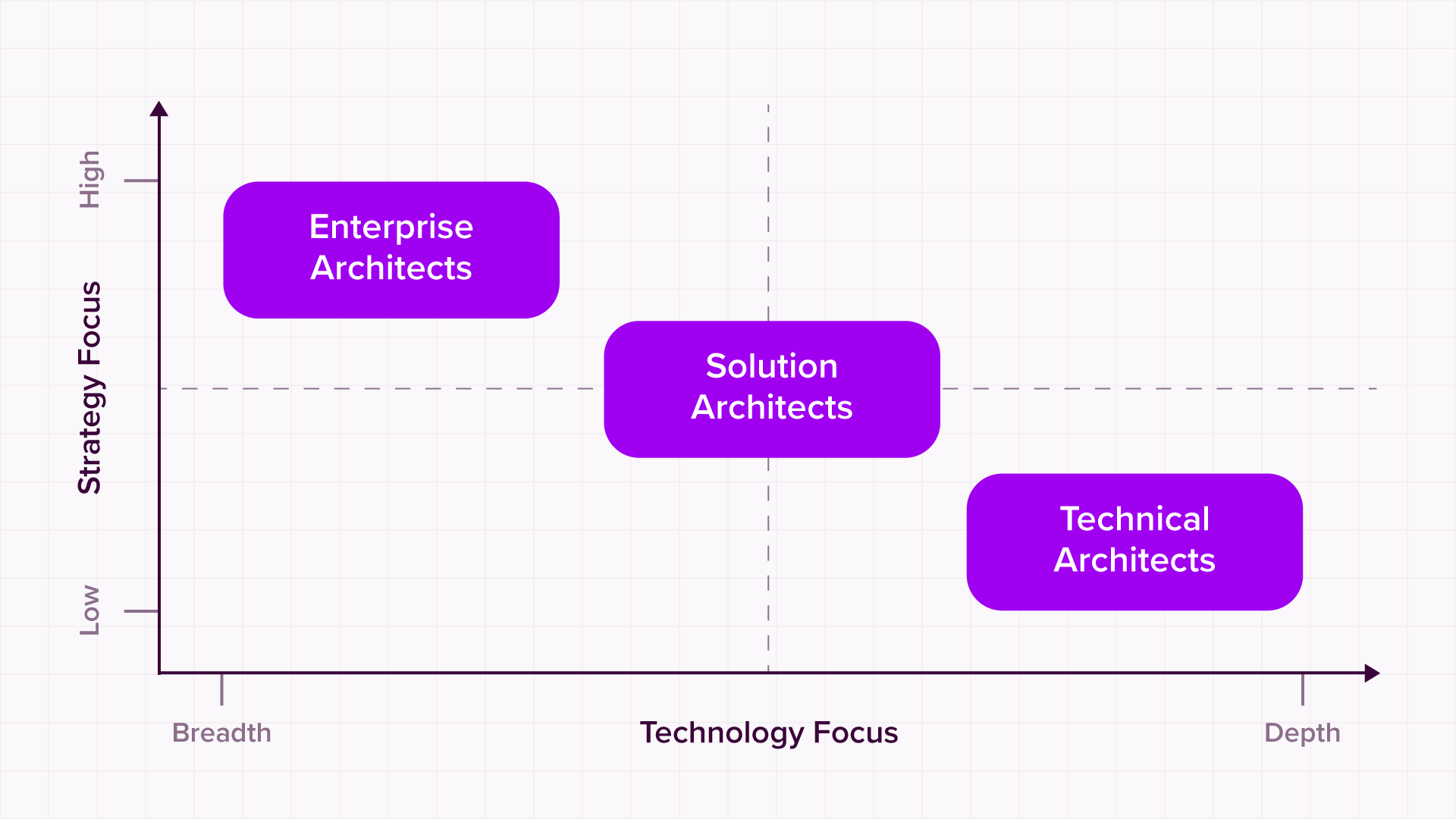As the digital revolution continues, organizations risk being left behind if they don’t upgrade their technology. However, digital transformations only have 30% success rate. It’s a real battle to avoid the many pitfalls of implementing strategic change. The challenge is also ensuring that any new solutions are a perfect fit for your business and aligned with your goals. A tailor-made solution checks all the boxes—and that’s where solution architecture comes in.
Jump to:
- What Is Solution Architecture?
- What is the Role of a Solution Architect?
- When Does a Company Need Solution Architecture?
- Solution Architecture: What Are the Principles?
- What Are the Components of a Solution Architecture?
- 5 Benefits of Solution Architecture: What it Does For Your Business
- What Are Examples of Solution Architecture?
- Solution vs Enterprise Architecture: What Are the Differences and Similarities?
-
Implement Solutions That Will Bring Lasting Change to Your Organization With Ardoq Platform
What Is Solution Architecture?
Solution architecture (SA) designs and delivers technological solutions that address specific business challenges. It involves tailoring the solution to the organization’s requirements and ensuring it fits into the Enterprise Architecture (EA).
Solution architecture begins with evaluating the current IT landscape and the company’s needs and objectives. It proposes a blueprint for a solution to improve the business, such as moving an existing application to cloud technologies or exploiting new innovation to address costly business challenges. (such as cloud computing or a complete digital transformation) and provides a supportive framework for its implementation.
The resulting architectural documentation should include guidance for effective implementation and delivery of the solution and integrate well with the enterprise’s existing architecture.
What is the Role of a Solution Architect?
Solution architects are the ones who develop solution blueprints to meet particular business needs and make those plans a reality. They ensure that their technical solutions align with business goals. On a typical day, a solution architect would work closely with project managers and engineering teams to design the architecture of a specific system, including software, hardware, and networks. Their role involves understanding both the technical requirements and the business needs, to create a solution that is both technically viable and meets the business objectives within prescribed project constraints.
A solution architect is usually responsible for:
-
Designing detailed technical solutions that meet specific project objectives
-
Ensuring that individual software projects align with the overall business strategy and technology standards
-
Working closely with development teams to guide the implementation of designed solutions
-
Evaluating project constraints to find alternatives, alleviate risks, and perform process re-engineering if required
-
Bridging the gap between technical and non-technical stakeholders
Thanks to their wide knowledge of available technologies, the solution architect will identify the best software and hardware for building this solution—in line with the available budget. They’ll share their findings as a SA document or diagram.
Once the plan is approved, the solution architect oversees the project and ensures it stays on track regarding time and budget. They’re also responsible for keeping stakeholders updated, which means translating technical project details into simple language.
When Does a Company Need Solution Architecture?
Solution architecture comes in many forms depending on the business needs. A company usually needs solution architecture when facing technological challenges, growth opportunities, or the need for strategic alignment between IT and business objectives. It might be that you’re developing new cloud infrastructure or microservices for internal teams, for example.
When faced with a business challenge, solution architecture is the evaluation of available technologies and the development of necessary components to achieve the desired solution. This includes analyzing all solution aspects, including budget, technology, risk, time, and quality, to identify limitations and plan solutions accordingly.
Solution Architecture: What Are the Principles?
-
Understand the problem or need: This requires thorough knowledge of the organization’s purpose, values, and goals, as well as its processes and existing enterprise architecture.
-
Find the best possible solution: This means a solution that meets all requirements while balancing the constraints and available resources of the project and avoiding negative impacts.
-
Build for the future: It’s important to design and deliver a scalable solution that can adapt and evolve to meet future needs and requirements.
-
Communicate effectively: As well as sharing the vision and roadmap with business leaders, solution architects must foster collaboration between the teams and stakeholders involved in delivering it.
-
Validate the solution: This should be done throughout the solution’s lifecycle to make sure that it continues to meet all requirements and avoids unnecessary risks.
What Are the Main Processes of Solution Architecture?
-
Identify business objectives: What are the challenges faced by the organization? What does it hope to achieve with the solution? What factors might prevent success?
-
Identify requirements: Ensure that the solution takes into account the functional requirements of all stakeholders. It must also meet non-functional requirements such as security and compliance, performance, usability, reliability, and scalability.
-
Design the solution: Create conceptual models that show how a solution and its various components will work. Select an appropriate technology stack for the project and present its estimated cost.
-
Create a roadmap: This detailed document outlines the plan for implementing the solution, showing the schedule and the roles and responsibilities of those involved.
-
Implement the solution: Guide the organization through the implementation, ensuring that everyone sticks to the plan. Check that it integrates properly with existing systems and the overall enterprise architecture.
-
Monitor and adjust: Collect data on the performance and usage of new systems, and keep an eye out for any issues and opportunities to improve.
What Are the Components of a Solution Architecture?
Solution architecture treats a solution as a system with component parts that work together for the desired outcome.
-
People: These are the organization’s team members who will implement and/or use the solution; customers or end-users of the company’s product or service; and external partners who will support new processes. Define their roles, skills, and capabilities.
-
Organization: The organization's structure and how it works—its management hierarchy, departments and teams, and partner organizations.
-
Processes: Any activities carried out to pursue the organization’s purpose and goals. This includes all business operations and the accompanying policies and regulations.
-
Information: Including data collected from users and partners (input) and the reports and business intelligence gleaned from it (output). Also, records of business transactions.
-
Technology: Any tech tools and systems the organization uses, including computer hardware, software, and communications; Internet of Things (IoT); cloud platforms; manufacturing capabilities.
5 Benefits of Solution Architecture: What it Does For Your Business
So, is solution architecture necessary for your business? Here are five significant benefits that prove its worth.
Provides a Tailor-Made Solution
Solution architecture is designed to address or mitigate specific organizational needs. The solution architect studies precisely how your organization works before proposing a bespoke solution that factors in all functional and non-functional requirements and your available resources. The solution must also fit into your enterprise environment, meaning you can use it immediately with minimal integration issues.
Aligns Technology With Business Goals
Solution architecture is always based on a specific business need. It’s not necessarily about fixing a problem, although this is often the reason for the project. Your organization’s “need” can also be a goal, such as raising profits by 20% or becoming a leader in your industry. The solution architect will design a proposal that can be translated into practical IT solutions that align with your objective and turn the vision into reality.
Improves Budgeting
Whether it’s new software or a complete digital transformation, your solution architect will explain in detail how much it will cost and the resources you’ll need to do the job. This means you’ll be able to set more accurate budgets for the project and allocate resources to the right teams.
Increases ROI
When architecting a solution, the solution architect will seek out technology that offers your organization the best possible value for money, combined with optimum performance. By improving your business processes without overspending, solution architects work towards ensuring the best possible ROI.
Future-Proofs the Business
Solution architects are up-to-date on the latest trends in EA and SA. They can put a technical solution in place that not only meets your requirements right now but also has you covered for the future. This creates the foundations for scalable and flexible solutions that will enable sustainable growth.
What Are Examples of Solution Architecture?
Solution architecture covers a range of architectural disciplines, which all come within the sphere of Enterprise Architecture. While architects tend to disagree on a single definition or scope, SA most commonly covers the bottom three items on this list.
-
Business Architecture
Business solution architecture focuses on aligning business strategies with technology. The solution architect identifies business objectives and outlines the processes and tools required. They typically use a business capability map that summarizes what the company does and how the right solution will have a positive impact on business outcomes. -
Information Architecture
This type of architecture describes the structure of a user interface and enables organizations to think about their products and services from the users’ perspective. For instance, if the company wanted to increase website traffic, the solution architect might suggest ways to make the navigation more user-friendly. -
Information Security Architecture
Whether you’re integrating a new tool or replacing the whole IT system, the solution architect will build information security into the solution. They’ll advise on the latest technology and make sure it aligns with your existing security policies. They’ll also document how the solution will comply with industry regulations. -
System Architecture
System architecture is a subset of SA, concerned with the structural design of IT systems that automate processes. This includes selecting services, layers, and components and the design of the interface. Solution architects use conceptual models to determine the placement and behavior of each component. -
Application Architecture
Solution architects use application architecture to create a structural map of all the applications used by the organization, to make sure they deliver the required functionality. The map defines how they are assembled and interact with each other, as well as with middleware and databases. -
Technology Architecture
Technology architecture describes the design of the IT infrastructure for the new solution. It details the tech components involved and the relationships between them. It also ensures that hardware, software, and operating systems work together as they should.

Solution vs Enterprise Architecture: What Are the Differences and Similarities?
Now we come to the question of Enterprise Architecture vs solution architecture. The two disciplines are sometimes confused, probably due to the close working relationship between solution architects and enterprise architects and the overlap between them.
Let’s take the similarities first. Both have the same objective: using the right technology to improve business processes and revenue and mitigating the impact of its implementation. Both require a deep understanding of the organization's work and close collaboration with IT and business leaders.
The difference is that SA focuses on the details of the project, while EA is all about the big picture. Enterprise Architects take a holistic, high-level view of what needs to be done, and solution architects are tasked with deciding how to achieve it. It’s overarching strategy vs detailed planning.
As solutions architecture is concerned with finding technological solutions to a specific business problem or need, we can say that it acts as a bridge between enterprise architecture and technical architecture.
Solution Architecture Methodology Basics
Here are some of the different methodologies used in solution architecture:
- Layered pattern: This technique arranges software components into separate layers. Each has a specific responsibility and communicates through distinct interfaces.
- Microservices pattern: This splits the software system into self-contained services, each responsible for a single business capability or domain. Because they can be developed and scaled independently, the system is more flexible.
- Event-driven pattern: In this methodology, events (such as a user clicking a particular button) cause the software components to react and behave in a certain way.
- Serverless pattern: This involves running software components on cloud computing platforms, which manage the servers and infrastructure—reducing complexity and cost.
- CQRS pattern: “Command Query Responsibility Segregation” separates data handling for writing and reading, which improves scalability.
Implement Solutions That Will Bring Lasting Change to Your Organization With Ardoq Platform
The purpose of solution architecture is to implement the ideal technological solution for your organization—a solution that sets you up for success both now and in the future. It takes hard work to get it right, but it needn’t be daunting if you use the right tools. Undoubtedly, the more complex the project, the more likely you’ll need architecture solutions to steer you through and reduce the risks.
With Ardoq, it has you covered for all the disciplines under the EA umbrella, including solution architecture. It’s more than an Enterprise Architecture tool designed to help organizations navigate strategic change, such as digital transformation, with expert guidance in product configuration, use case adoption, and industry best practices.
The software also helps you overcome the disconnect between IT and business by enabling a deeper understanding of the relationships between people, processes, technology, and data. Ardoq’s centralized platform organizes your data and makes it readily accessible to decision-makers through real-time dashboards and graphs.
Ardoq Scenarios
The Ardoq Scenarios feature lets you visualize your business and IT landscape with data-driven scenario analysis to simulate and compare current and future states. You can build your own models or use Ardoq’s ready-made solutions—including:
- Application Rationalization
- Application Portfolio Management
- Business Capability Modeling
- Cloud Migration Planning
- ERP Transformation
As well as saving time through automation, Ardoq allows you to accelerate your time-to-value and save $1m or more in annual costs lost to inefficiencies and redundant technology. The platform ensures that your architecture can stay lean and effective, evolving with your organization.
Request a demo to see how Ardoq can help you architect more effective solutions in your organization
 Ardoq
This article is written by Ardoq as it has multiple contributors, including subject matter experts.
Ardoq
This article is written by Ardoq as it has multiple contributors, including subject matter experts.






